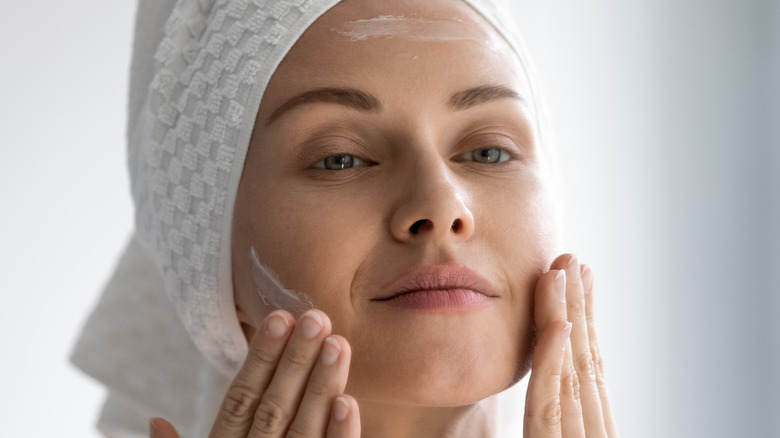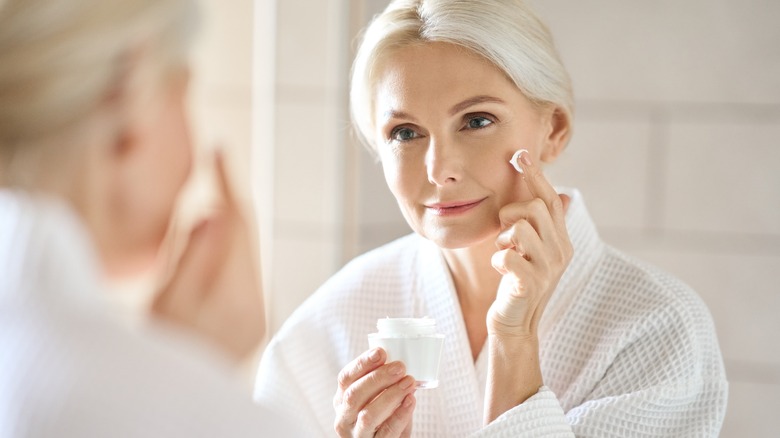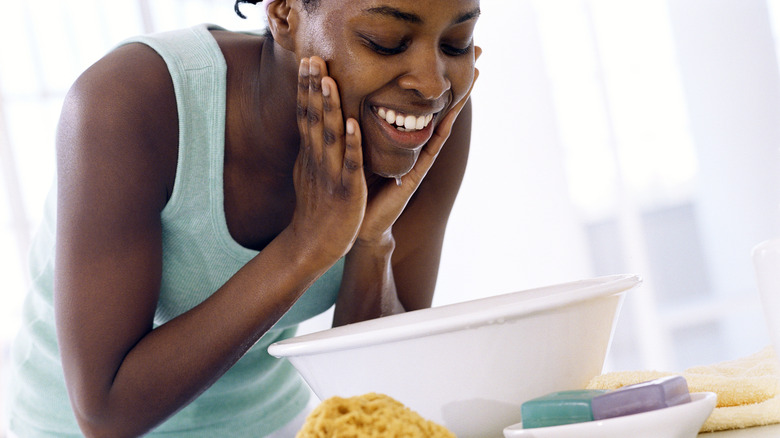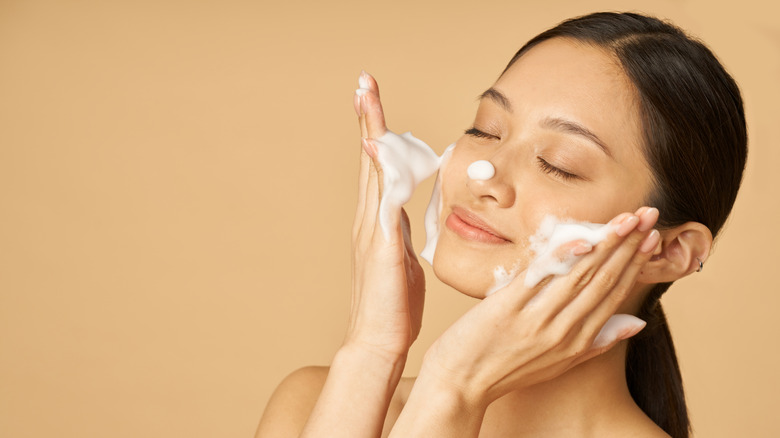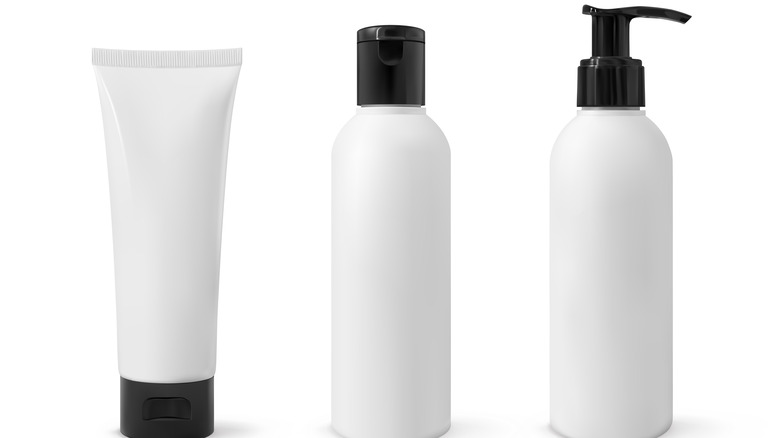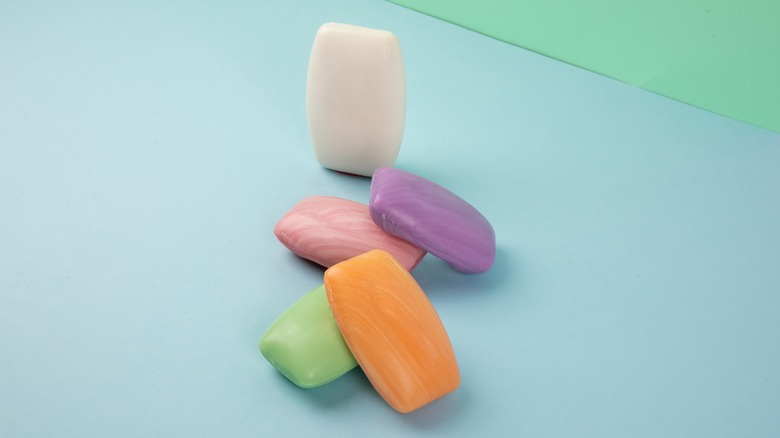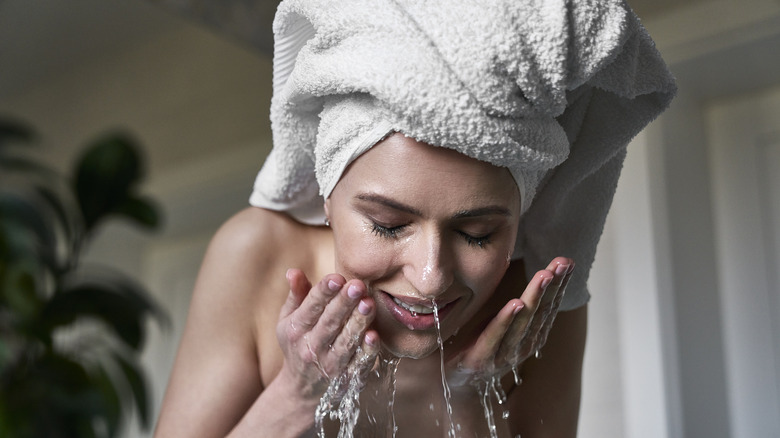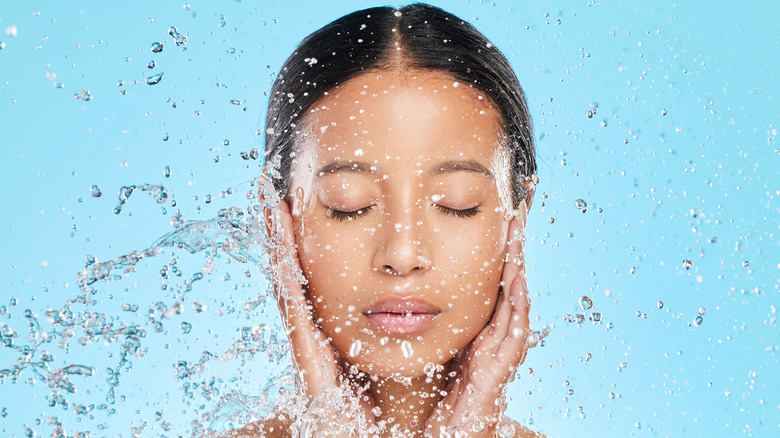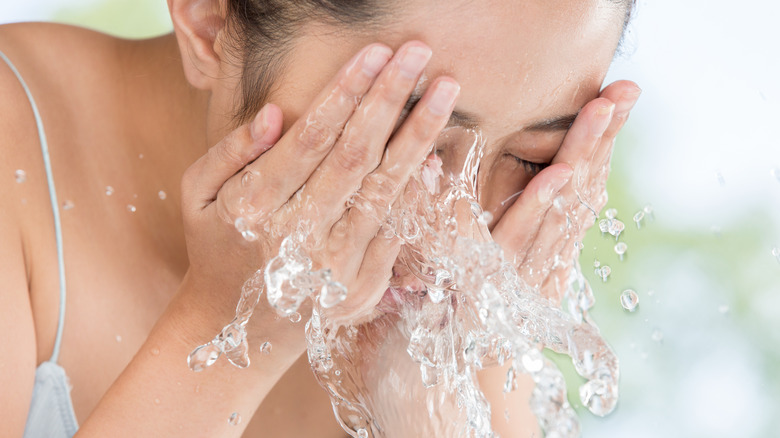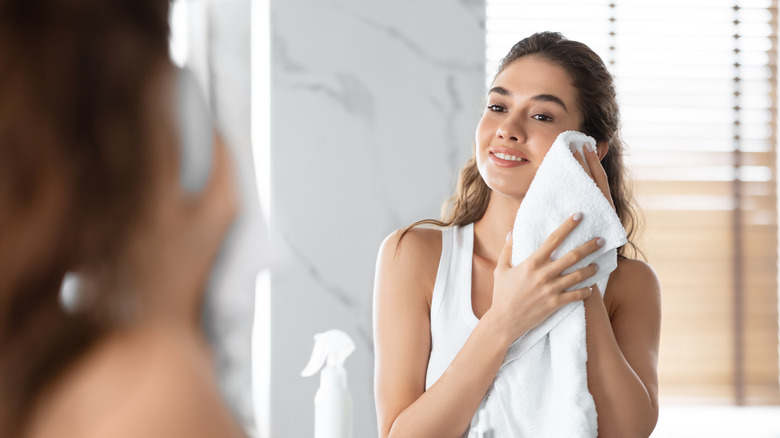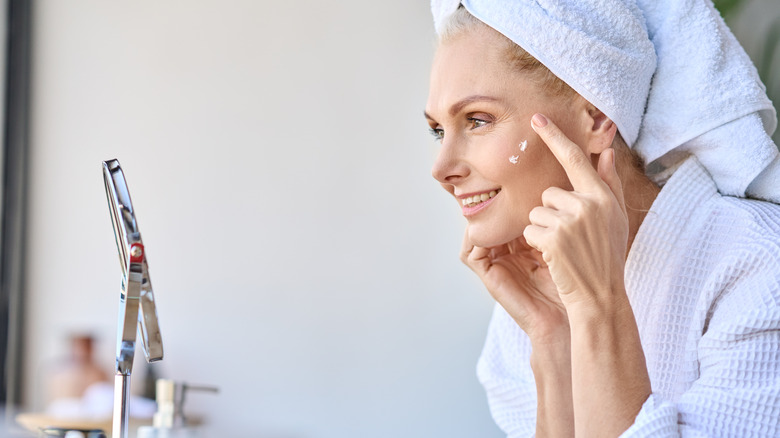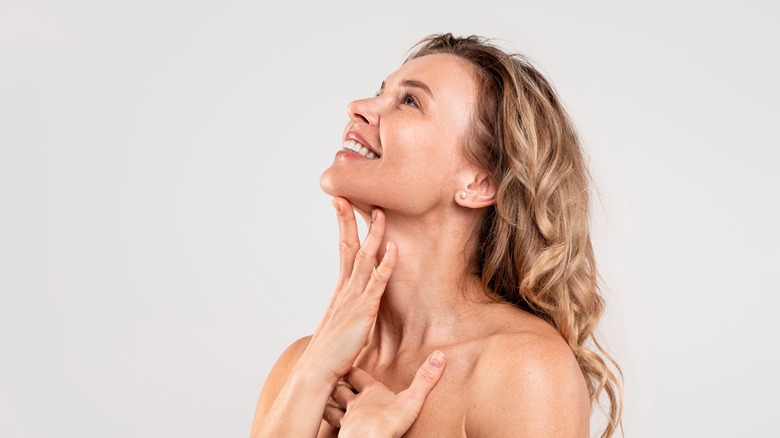Dry Cleansing: An Unconventional Way To Wash Your Face
Depending on who you are, the question of how to wash your face is either the easiest or toughest question to answer. If you're a low-maintenance type who's happy with your skin, you might not give the matter a moment's thought. But if you have sensitive or breakout-prone skin, or wear and remove makeup frequently, you may agonize over whether you're washing your face the right way — are you over-stressing your skin or not cleaning it enough?
While dermatologists agree that using a gentle cleansing product and lukewarm water are best practices (per NBC), skincare experts have never stopped exploring new ways to optimize the daily cleaning routine. And among one of the simplest and most talked-about of their innovations is dry cleansing — the practice of applying face cleanser to your face without wetting the skin first. "Dry cleansing is the best-kept secret in the home skin-care universe," esthetician Rosalia Fiske told Bustle. And Fiske isn't the only one raving about the practice. Here's what you need to know to determine if dry cleansing is right for you.
Here's why skin care experts love dry cleansing
The idea of rubbing face cleanser directly onto your dry face may sound counterintuitive. But skin-care experts say it's actually a more logical and efficient way to ensure a clean face. As dermatologist Morgan Rabach explained to Bustle, dry cleansing lets you benefit from the full cleaning power of your cleanser, since it isn't diluted with water, and thus ensures that excess oil, dirt, and makeup are fully removed from your face.
To clarify, dry cleansing isn't a completely dry process. You still wet your fingers to massage in your cleanser after you apply it and rinse your face normally when you're done. But even though you wash off your cleanser in a conventional way, dry cleansing still allows your skin to absorb more of — and thus obtain greater benefit from — your cleanser's active ingredients. "It's possible if your cleanser has active ingredients (like acids) or antibacterials (like benzoyl peroxide), then they will be a little more active before they are mixed with water," esthetician Jordana Mattioli told PopSugar.
Dry cleansing offers extra benefits for some skin types
While dry cleansing doesn't seem that different from conventional face washing — it's basically the same thing with the initial step of wetting your face omitted — it can have noticeably different effects. Because your cleanser is more concentrated when first applied to the skin and massaged in, you get a deeper clean than you would with conventional washing, according to Bustle. This makes dry cleansing ideal for those for whom impurities on the face are a special concern, such as those likely to be exposed to dirt or those who wear makeup (which dermatologist Shasa Hu recommends that you remove before you wash your face, per Insider).
The deep cleaning power of dry cleansing also makes it a beneficial technique for those with large pores or who are susceptible to clogged pores. Large pores are more likely to trap dirt and oil, causing blackheads and zits, as ethetician Annet King told Glamour. Thus, the more powerful cleaning action of dry cleansing can be a powerful first line of defense against blemishes.
Dry cleansing is not for everyone
While dry cleansing is a gentle cleaning technique (provided you use an appropriately gentle cleanser) and safe for most skin types, like most skin care techniques, it's not for everybody. Dermatologist Hadley King advised PopSugar that those with very oily skin, who can obtain the most benefit from using stronger foaming cleansers, should not try dry cleansing, since foaming cleansers are too harsh to be rubbed directly into dry skin.
In addition, dry cleansing should be approached with caution if you have sensitive or easily inflamed skin. As dermatologist Ryan Turner explained to Bustle, the friction of certain cleansers against dry skin can potentially trigger further irritation and should thus be avoided. And, as dermatologist Joshua Zeichner told PopSugar, dry cleansing is not a good option for the lazy: If you tend to rush your face washing routine and aren't always super mindful about rinsing off your cleanser completely, you could be courting trouble. "Removing the cleanser from the skin is as important as applying it, as not fully removing the cleanser can lead to skin irritation," he said. "Leaving the surfactants on the surface of the skin can disrupt the outer skin layer."
These are the best types of face cleansers for dry cleansing
Because dry cleansing exposes your skin to undiluted face cleanser, it's especially important that the cleanser you use be gentle enough not to irritate or dry out your skin, either during or after washing. This means, as aesthetician Jordana Mattioli told PopSugar, your cleanser should not feel sticky — it should glide easily over your face when you apply it, without pulling at your skin.
Mattioli recommends non-foaming oil- or cream-based cleansers, both for their feel and their gentleness to the skin. In addition, dermatologist Loretta Ciraldo recommends cleansers with nourishing actives, such as aloe vera, hyaluronic acid, plant-based oils, or ceramides. The good news is that products that are safe and appropriate for dry cleansing are not hard to find, and some are budget-friendly supermarket products you may be using already. Among these, according to PopSugar, are the Simple Skin Moisturizing Face Wash and Dove Go Fresh Face Cleanse. A more luxurious, but still accessible, choice recommended by dermatologist Hadley King is the Shea Moisture Cannabis and Witch Hazel Skin Rescue Cream Cleanser.
Some types of cleansers are not ideal for this method
Because dry cleansing involves rubbing fully concentrated face cleanser into your skin, it's quite possible that products that you may have found effective and non-irritating for conventional wet face washing cause irritation or other unpleasant effects when used for dry cleansing. As dermatologist Ryan Turner told Bustle, this irritation could be due to the additional friction of applying cleanser without water, or from the ingredients in the cleanser itself.
This doesn't mean there's anything inherently dangerous about these products — rather, they were designed specifically to be applied with water. For instance, dry cleansing with abrasive face scrubs is an obviously terrible idea (just imagining what that might feel like will explain why.) As esthetician Jordan Mattioli explained to PopSugar, using any cleanser other than as directed by the manufacturer is a risk."If you're using a cleanser differently from how it's intended, then it just might not be the best idea," she said. But since very few cleansers (if any) are designed specifically for dry cleansing, she offers a tip for minimizing your risk: "As long as you feel your face wash is slippery enough where it's not tugging on your skin while you massage it in without water, then it's safe," she said.
How often should you dry cleanse your face?
No matter how you wash your face, over-washing can be just as damaging as under-washing. "When you wash your face, removing that oil barrier can actually be detrimental," dermatologist Jordan Carqueville told "Today." "So if your goal is hydration, and you've got really sensitive skin, over-washing your skin is going to remove the natural oils that are serving to protect you."
For most people, according to Cosmopolitan, cleansing your face twice a day with a gentle cleanser — after waking up and before going to bed — is appropriate. And since dry cleansing is just a way to improve your face-cleaning routine, we can assume two dry cleanses a day will be suitable for most people. Still, these aren't universal rules, and because your needs will vary with your skin type and daily routine, Cosmopolitan notes you might be able to get by with just one thorough cleanse and a quick rinse per day.
Here's why you should take your time when dry cleansing
No matter what your skin care routine may be, if you've had the same one for a while, you probably do it on autopilot — do you actually remember exactly how you washed your face this morning? But dry cleansing, like pretty much any activity worth doing, works best when done mindfully and intentionally. Because dry cleansing is a bit counterintuitive, you'll probably be paying more attention to what you're doing when you first get started — and this is the time to develop good habits.
When dry cleansing, according to Bustle, it's not enough to just rub in some cleanser and rinse it off. To get the most from the cleanser, first apply it to your dry face with dry fingers, then massage it into your face gently using upward strokes. Let the cleanser sit for a few moments, then wet your fingers with lukewarm water and continue to massage in the cleanser. Once you're done, rinse your face thoroughly with lukewarm — not hot or cold — water to ensure the cleanser is completely removed.
Water still matters when dry cleansing
Contrary to its name, dry cleansing does not mean a completely water-free cleanse. It just means water is used a bit differently — and still plays an important role in most stages of dry cleansing. For starters, it's critical for a face-cleansing step you may not have thought of: cleaning your hands before you wash your face. As skin-care professional and spa owner Angela Jia Kim explained to Allure, if you're using your hands to clean your face, the last thing you want is for your hands to re-introduce even more dirt.
And once you've washed and dried your hands and applied cleanser to your dry face, it's almost time for more water. As esthetician Rosalia Fiske explained to Bustle, before turning on the tap again, you should first massage the cleanser into your dry face with gentle, upward strokes. This, Fiske explains, helps it get into the pores and loosen any impurities. Next, run your hands under lukewarm water and massage the cleanser into your face again to start dissolving the cleanser. Finally, it's time to rinse your face thoroughly by splashing it with lukewarm water.
Pay attention to how you dry your face, too
If you're serious about skin care, you know that cleansing your face is just the start of your routine. And if you're really, really serious about skin care, you know that every detail of every step can make a difference. So even if you've executed your nightly dry cleanse flawlessly, all your good work could be wasted if you botch the next step: drying your face.
The low-maintenance among us may wonder what's the big deal about drying your face — why not just grab the nearest dry towel and smoosh it against your wet face? And if this works for you and your skin, keep doing it. But as several dermatologists told Allure, there are good and bad practices for drying your face. First, they recommend patting your face gently with your towel, rather than rubbing it against your face, which can cause irritation. Second, don't over-dry your skin — a bit of moisture will jump-start your moisturizing routine. And as skin care expert Angela Jia Kim explained to Allure, you should be sure to dry your face with a clean towel — you don't want to be re-applying bacteria and dirt onto your freshly-washed face.
Nighttime cleansing is especially important
We get it: Much as we all love looking good, the time and effort of a twice-daily skincare regime can be a pain, especially when we're tired, busy, or running late. But as Cosmopolitan notes, depending on your lifestyle and skin type, you might be able to safely get away with just one thorough wash or dry cleansing a day. If you have sensitive skin, for instance, you might find your skin less irritated if you give your face a quick rinse rather than a second daily wash or dry cleanse, according to Self.
But if you choose to do just one dry cleanse a day, the experts agree that you should make your evening cleanse a priority, since it's critical for cleaning off all the dirt, oil, and makeup residue your skin has accumulated over the course of the day. "If you experience specific issues that require attention in the morning it's fine to do it then, but I see more benefits at the end of the day when you return from work or go to bed," dermatologist Todd Minars told NBC. And as Cosmopolitan notes, allowing a day's worth of grime and oil to build up on your face overnight can wreak havoc over time, leading to dull skin and breakouts.
Here's what to do after dry cleansing
For many people, dry cleansing — like standard face-washing — is just the first step in a skincare routine. And because dry cleansing cleans your pores so thoroughly, it leaves your skin in a good position to benefit from whatever products you apply next.
The right products to apply after dry cleansing will vary with your skin type and lifestyle. And the right routine for you might be the simplest one: As a panel of dermatologists advised Cosmopolitan, a good minimalist routine involves nothing more than a cleanse followed by moisturizer and sunscreen (during the day). Optional steps including applying toners (which remove any remaining impurities, tighten the pores, restore your skin's natural pH levels, and smooth your skin, per Neutrogena), serums (which target signs of aging, according to Harvard Health Publishing), then eye cream, spot treatments, and moisturizers. Chances are, you won't want or need all of these, but if you do use any of them, they should be applied in the proper order: toner first, followed by serums, eye cream, spot treatments, and finally, moisturizers. As a general principle, Cosmopolitan notes, you should start with the lightest products and end with the heaviest ones.

